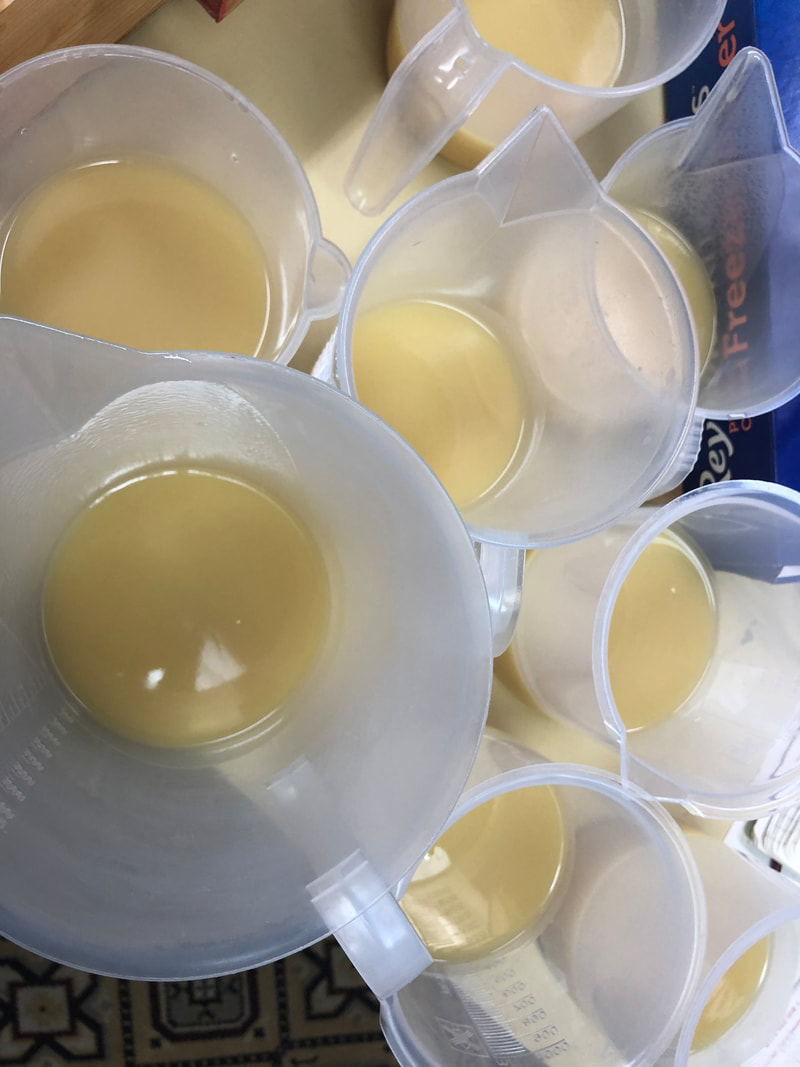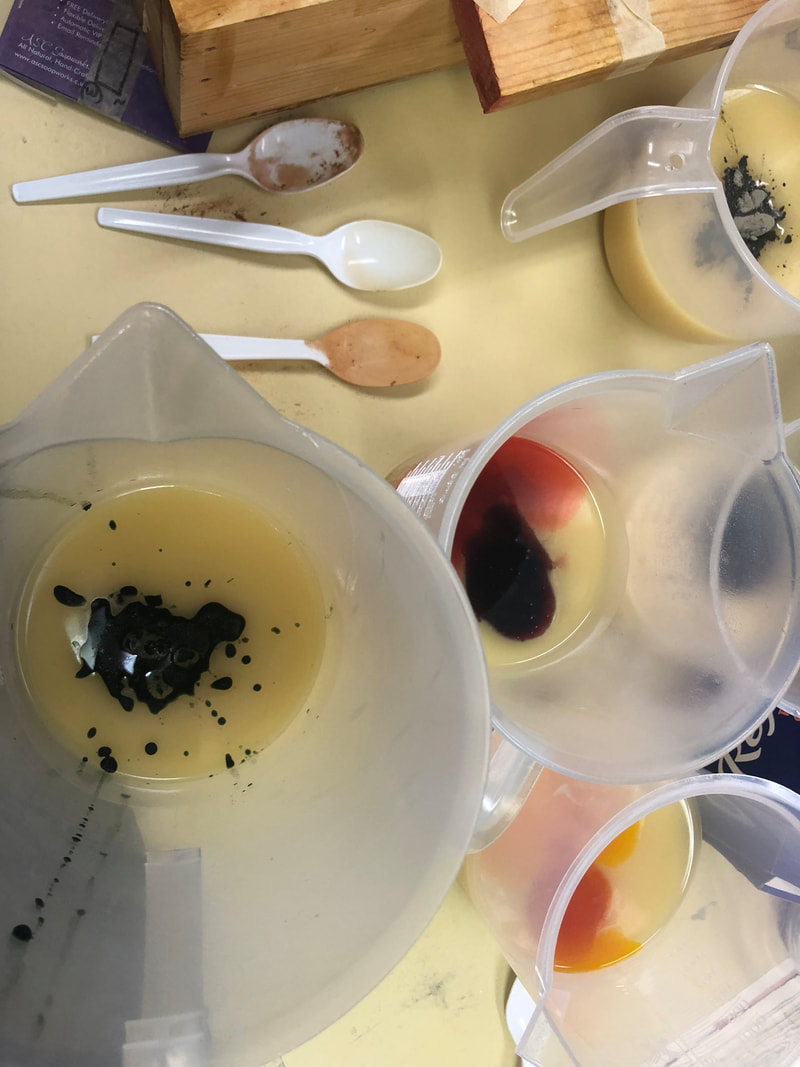|
Glycerin Rivers are a phenomenon that many soap makers try to avoid, but this month it is the topic of the Amy Warden's Soap Challenge. This is a chance to learn more about the chemistry of the soap recipe through purposely creating these lines and cracks. If mastered, this would provide the opportunity to use these as an interesting design element. These "rivers" are not really glycerin as they are called, but rather an absence of pigment particles in part of the soap. First seen in soaps utilizing titanium dioxide to whiten the soap, it is now known that the crackles and rivers are created when the soap batter is heated up and the colorant gets pushed to the side during gel phase. So, the requirements for making a soap with this element are firstly to use a colorant, and secondly to ensure that the soap goes into a total gel state by sufficiently warming it up as it cures. Auntie Clara has perfected this technique and has shared her wisdom with us this month on how to create a recipe that will work. One of the tips she gave was to use a recipe high in oleic, palmitic and stearic acids and low in linoileic, linolenic, lauric and myristic acids. I played with my recipe using my Soapmaker 3 program and landed on a recipe that has 51% Oleic Acid, 18% Palmitic Acid and varying low amounts of the remaining oils. Now that I had my recipe, I needed to design the soap. Since I don't use titanium dioxide and only use natural colorants, I thought I would perform an experiment to see if and how well these colorants can be used in this technique. The colorants I used in this batch of soap are charcoal, paprika, rose clay, green sea clay, coffee, annatto seed, alkanet root, chlorophyll, cocoa, rhassoul clay, cinnamon and kaolin clay. I did not use a fragrance in this batch. I divided the batter up into 13 equal portions and added the appropriate colorant to each one. The thirteenth portion was left natural, no color, as a control of sorts. In this first batch, I added a teaspoon of colorant to each portion. As soon as I added the first colorant, I realized this was a bit much, but I decided to stick to it and continued with using a full teaspoon per portion. I was originally thinking of doing twelve separate sections with one color each, but my laziness got the better of me - I really didn't want to make so many dividers. So, I just poured each color in succession, hoping that the colors will be separated well enough to determine whether or not the rivers are formed. The natural batter was added as a thin layer on the top. This pouring method definitely gave a more interesting final product, so in retrospect, I'm glad I did it this way. After pouring the soap batter, the entire mold of soap was wrapped in a towel and put into a 175 degree oven to ensure even heating to create gel phase throughout. The heat was kept on for an hour and a half before being turned off. The soap remained in the oven overnight, it was actually still warm in the center when I pulled it out. There was also a small layer of oil lying on the top, which concerned me a bit. I then cut loaves (I had four separate loaves, giving very different designs and colors) and subsequent bars. I was really happy to see rivers in this first batch since so many people had difficulty in producing them. Some of the colorants did not produce any, and I feel that it may be due to the fact that it was a bit heavy on the colorant. Also, while typing up this post, I wanted to get a few more pictures, and I noticed that there are rivers today that were not there on Wednesday when I took the original pictures. So, I will put the two photos side by side to show how much more the rivers are pronounced as they have sat over the last four days. Looking at the photos, you can see that the coffee and kaolin clay produced decent rivers, as did the chlorophyll. I see a few small rivers in the charcoal as well. However, four days post cut, there are more pronounced rivers in the chlorophyll and I'm seeing them in the paprika, which I didn't see at cutting. Very interesting! There are a few small rivers in the cocoa, but I'm not sure if that is an artifact caused by the mixing of the colors, or rivers - a good reason to separate out the colors for the experiment. Overall, these bars turned out beautifully, regardless. In the vein of experimentation, I created a second batch, changed by the fact that I added less colorant to each portion, only a 1/4 teaspoon each. My theory is that the particles will be freer to move around? And, I added a fragrance to the new batch as well. These are the pics of the second batch, just after cutting. The rivers were better in the first batch that had higher concentrations of the colorants, so my theory wasn't correct. There must be another variable that would create the effect more predictably. However, there are some rivers along the edges of color, and I'm thinking that they will improve upon cure - we will see!
4 Comments
|
Details
TaralynColorado Artisan, making beautiful hand-crafted soaps with all natural ingredients. Archives
August 2025
CategoriesCategories
Comment Policy
We follow Grandma's rule here: If you don't have something nice to say, don't say anything at all. While constructive criticism is always welcome, keep it polite, considerate and friendly. These are simple rules that, if not followed, will result in the deletion of the comment. Thank you. |
|
|
Our soaps and body care products are handcrafted the old-fashioned way, in Boulder County, Colorado by your local Soap Making Artist, Taralyn. Small artisan batches allow for considerable attention to detail during all stages - soap making, hand cutting, six week cure time and hand wrapping - an extensive journey that nurtures the formation of the perfect bar of luxury soap. And to make it even better, we will deliver to your door! Shop by Signature or Artisan, by scent families, ingredients or by name. So much to explore! Check out our collections today!
|
Contact
|
About
Get to Know Your Soap Maker!
|
Customer Service
ASC Creative Credits
|
Other Goodies
Community Connection Blog
Wild Rovings Blog
Why Palm Oil?
Organic Label
|
Copyright © 2009-2025 ASC Soapworks, llc, All rights reserved.

























 RSS Feed
RSS Feed

